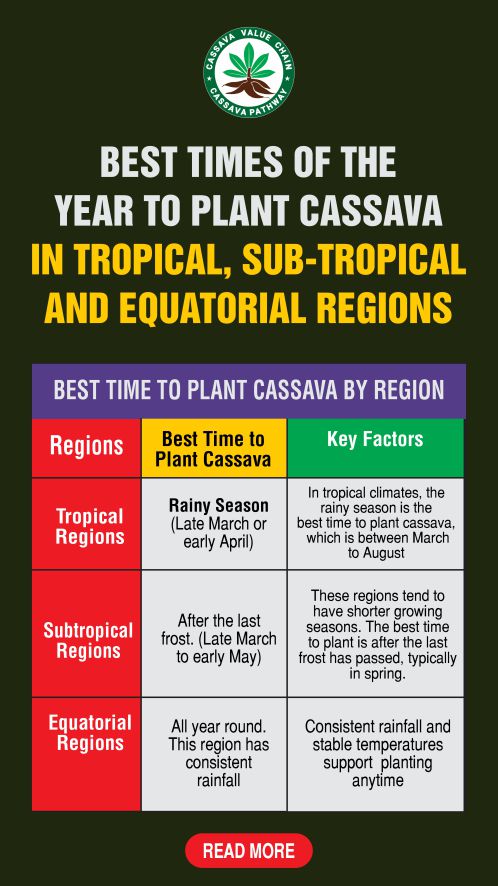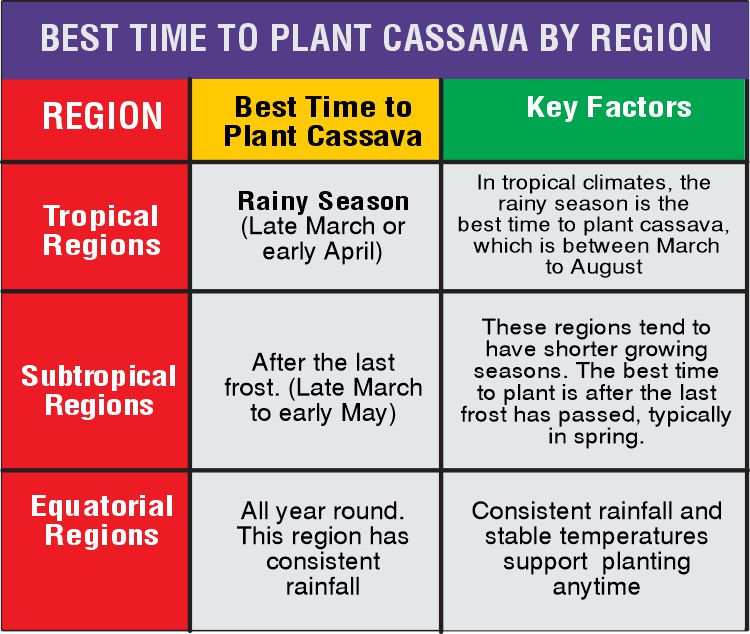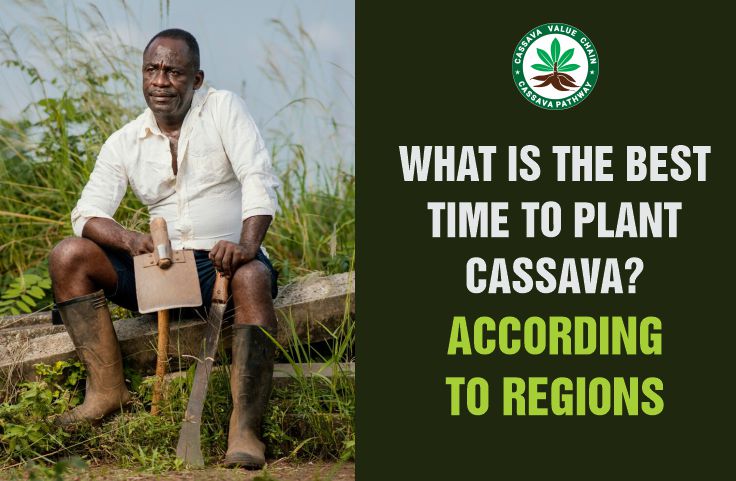Wondering when to plant cassava aka yuca for the best results? Learn the best time to plant cassava and get simple tips for a healthy, high-yield harvest every season.
Despite cassava’s resilience and minimal condition to thrive, optimal timing in planting is a factor influencing the overall yield and quality of the harvest that should not be ignored.
Understanding the best time to plant cassava is important for maximizing crop production, whether for commercial farming or home gardening.
Planting timing directly impacts root development, nutrient absorption, and overall productivity.
By aligning planting schedules with seasonal climate conditions, you as a cassava farmer can improve growth rates and improve plant health.
This article serves as a comprehensive guide, offering insights into optimal planting times and factors that influence them.
It aims to empower you to make informed decisions, ensuring high yields and promoting food sustainability in regions reliant on cassava, contributing to food security.
Let’s Go!

Table of Contents
- Understanding Cassava’s Growing Requirements
- Best Time to Plant Cassava by Region
- Rainy Season: The Key Factor
- Month-by-Month Planting Guide for Cassava
- Common Mistakes to Avoid
- Frequently Asked Questions
- Conclusion
Understanding Cassava’s Growing Requirements
For successful cassava farming, it’s important to understand its growing needs. Here’s what you should know to get the best results:
Climate and Temperature
Cassava thrives in warm temperatures, ideally between 25°C and 30°C. It can withstand periods of drought, but consistent rainfall between 500 to 1,800 millimeters a year is better for healthy growth.
The right climate helps support root development and overall plant health, ensuring good yields.
Humidity and Rainfall
Humidity is important, especially during the early growth stages. Cassava grows best in regions with long wet seasons, as it allows the plant to absorb enough water.
However, too much rain can lead to root rot and disease, so balance is key.
Soil Type and Fertility
Cassava grows best in well-drained, fertile soils. Sandy loam or light clay soils are ideal because they allow roots to expand easily and gather nutrients.
Make sure the soil has enough organic matter to support healthy growth. The ideal pH range is 5.5 to 7.0. This prevents nutrient imbalances that could limit root development. More on soil requirement for cassava.
Growing Cycle
The time it takes for cassava to mature depends on the variety. Most types take between 8 to 18 months to reach harvest.
Early-maturing varieties are ready sooner, while late-maturing varieties can be left in the ground longer for higher starch content and better root quality.
By understanding these key factors, you can plan your cassava planting for the best possible outcome.
Knowing when and how to plant will ensure you achieve a high-quality, productive crop.
Related: The Cassava Industry
Best Time to Plant Cassava by Region

The best time to plant cassava depends on where you’re growing it. Each region has its own ideal planting window based on climate and weather patterns.
Here’s what you need to know for each area.
Tropical Regions: Rainy Season is Key
In tropical climates, the rainy season is the best time to plant cassava.
Regions like Southeast Asia, West Africa, and parts of Central America experience heavy rains, which provide the moisture necessary for healthy cassava growth.
During this period, the soil is rich in water, which promotes robust root development and minimizes the need for additional irrigation.
This is important because cassava grows best in well-aerated, moist soil. For example, Nigeria and Thailand are known for their cassava production, and the optimal planting time is right before or at the start of the rainy season.
In my Nigeria, this is during March ending or early August depending on when the rain arrives.
Planting during the dry season, on the other hand, can lead to drought stress, stunted growth, and low yields.
Related: How to Apply Fertilizer to Cassava Plant
Subtropical Regions: Wait for Spring
In subtropical regions, like parts of Southern China, Florida, and South Africa, the timing of planting cassava is closely tied to the risk of frost and cooler temperatures.
These regions tend to have shorter growing seasons, which makes careful planning essential.
The best time to plant is after the last frost has passed, typically in spring. In South Africa, for example, farmers usually plant cassava between late March and early May, giving the plants enough time to establish themselves and reach maturity before the cooler fall temperatures arrive.
Subtropical areas are often more prone to sudden cold snaps, so planting too early can damage the plants.
Planting at the right time ensures that cassava can grow efficiently without the hindrance of cold temperatures.
Related: How to Preserve Cassava Stems
Equatorial Regions: Year-Round Flexibility
Equatorial regions, like those in Central Africa, Indonesia, and Brazil, offer flexibility for planting cassava throughout the year.
With consistent rainfall and stable temperatures, these areas do not experience the seasonal shifts that other regions face.
As a result, cassava can be planted at any time during the year based on local market demands.
In Brazil’s Amazon Basin, for instance, farmers can plant cassava at any time, depending on the specific needs of the market and harvest timing.
This flexibility also means farmers can adjust planting schedules to increase profitability by aligning harvests with peak market prices.
For example, by planting during times of high market demand, farmers can sell their cassava at better prices.
Understanding these market-driven factors, alongside environmental conditions, helps farmers make informed decisions on planting times.
Here’s a table summarizing the best times to plant cassava based on different regions:
| Region | Best Time to Plant Cassava | Key Factors |
|---|---|---|
| Tropical Regions | Rainy season (March or early August) | Heavy rains provide necessary moisture for root development. Planting during the rainy season ensures robust growth and reduces irrigation needs. |
| Subtropical Regions | After the last frost, typically in spring (Late March to early May) | Subtropical regions face cooler temperatures and frost risk. Planting after the frost avoids damage and ensures sufficient growth time before cooler fall temperatures. |
| Equatorial Regions | Year-round flexibility | Consistent rainfall and stable temperatures allow planting anytime, based on market demand. Timing can align harvests with peak market prices for profitability. |
Related: How to Cut Cassava Stems the Right Way
Rainy Season: The Key Factor
When you’re planting cassava, the rainy season plays a key role in determining how well your crop will perform.
Cassava needs enough moisture to grow properly, and the right amount of rain during the planting period is essential for healthy root development.
If the soil doesn’t have enough moisture, your cassava plants won’t thrive, and the yield will be much lower.
Timing is important when planting cassava in the rainy season. If you plant too early, the young plants get all the moisture they need right from the start.
But if you wait too long, the soil might become too saturated, causing waterlogging that can stunt root growth and make the plants more susceptible to diseases and pests.
On the other hand, if the rain doesn’t come through as expected, or if you plant too late, your cassava roots won’t develop properly.
The lack of water will stress the plants and result in smaller, less marketable roots.
This is why understanding when to plant during the rainy season is critical for ensuring your cassava thrives.
The rain is a deciding factor in both the timing and success of your harvest, and choosing the right moment to plant can make or break your crop’s productivity.
Related: What is the Standard Spacing for Cassava Planting?
Month-by-Month Planting Guide for Cassava
Planting cassava at the right time makes all the difference in how well it grows.
In places like West Africa, where the weather plays a huge role in farming, knowing when to plant helps you get the best results.
Here’s a month-by-month guide to help you plan your cassava planting.
January to March: Avoid Planting During Dry Season
From January to March, the dry season takes hold, bringing high temperatures and little rain.
These months are not suitable for planting cassava since the soil lacks the moisture needed for healthy root development.
Instead, use this time to prepare your land. Clear weeds and get the seedbed ready so that once the rainy season starts, you’ll be all set to plant.
April to May: Ideal Time to Plant
April and May mark the beginning of the rainy season. This is the best time to plant cassava, as the soil receives the moisture it needs to support new growth.
Planting at the start of the rainy season helps your cassava cuttings establish strong roots, which is crucial for a successful crop.
Take advantage of the steady rainfall during these months to give your cassava the best chance for growth.
June to August: Mid-Season Planting
From June to August, you can still plant cassava, but the timing requires a bit more attention.
Weather conditions can vary, so it’s important to monitor rainfall closely. Make sure the soil has enough moisture, and ensure there’s proper drainage to prevent root rot.
If the rain is inconsistent, you might need to adjust your planting times or use irrigation to help maintain soil moisture.
Related: Climate Impact on Cassava Farming
Related: Climate Impact on Cassava Farming
September to December: Avoid Planting
As the year progresses into September, the risk of dry spells increases, which makes this period less ideal for planting cassava.
The soil can dry out, and the approaching dry season may prevent roots from establishing properly.
It’s best to avoid planting during these months. Focus on managing your existing crops, or start preparing for the next planting season instead.
By following this month-by-month guide, you can time your cassava planting for the best results.
Proper timing not only ensures your cassava grows well but also helps you get higher yields, so you can maximize your efforts.
Related: Signs Cassava is Ready to be Harvested
Common Mistakes to Avoid
Planting cassava can be highly rewarding, but there are a few mistakes you need to watch out for to ensure you get the best results.
Here are some common errors that can affect your cassava crop and how to avoid them.
Planting Too Early
One of the biggest mistakes you can make is planting cassava too early, before the rainy season begins.
Cassava needs moisture to establish strong roots, and planting in dry conditions can result in poor growth or even crop failure.
If you plant too early, the soil might not have enough water, which is crucial for healthy root development.
It’s best to wait until the rainy season starts to ensure the plants get the moisture they need.
Delaying Planting Too Long
On the flip side, waiting too long into the rainy season to plant cassava can cause problems too.
If you delay planting past the optimal time, you could face excessive rainfall or flooding, both of which can cause root rot and increase the risk of diseases.
Aim to plant your cassava within the ideal window to avoid these risks and ensure healthy growth.
Proper timing ensures your cassava gets consistent moisture and the best chance for strong, high-yielding roots.
Ignoring Regional Climate Differences
Another mistake is not accounting for regional climate variations. Different areas have different rainfall patterns and temperatures, which can affect when you should plant your cassava.
If you’re not familiar with the climate in your area, it’s worth doing some research. Consider factors like rainfall patterns, temperatures, and soil types.
In regions with unique climates, you may need to adjust planting dates or choose specific cassava varieties that are better suited to local conditions.
Frequently Asked Questions
When is the best time to plant cassava?
The best time to plant cassava is at the beginning of the rainy season when the soil is moist and fertile.
Can cassava be planted in dry regions?
Cassava can be planted in dry regions with supplemental irrigation, but rain during the planting season is ideal for growth.
How long does cassava take to mature?
Cassava typically takes 8 to 18 months to mature, depending on the variety and climate conditions.
What are the common mistakes in planting cassava?
Common mistakes include planting too early or too late, which can lead to poor growth or root rot.
Conclusion
The key to a successful cassava harvest lies in understanding your local climate and knowing the best time to plant cassava.
By aligning your planting schedule with the early rainy season, you can ensure optimal soil moisture, encouraging healthy root growth.
Monitoring weather patterns and adjusting accordingly will help you avoid the risks of drought or excess rain, both of which can harm the crop.
With a bit of planning and local knowledge, you can maximize cassava yield and ensure the best possible results.
Stay proactive, track seasonal changes, and tailor your approach for the best harvest.
References
- Effects of cassava (Manihot esculenta) planting times on economic profitability in Nigeria
- Cassava Growth and Yield at Different Planting Times in Alagoas, Northeastern Brazil

Chimeremeze Emeh is a writer and researcher passionate about Africa’s most transformative root crop—cassava. Through his work at cassavavaluechain.com, he explores the entire cassava industry, from cultivation and processing to its diverse applications in food, health, and industrial use.
He also writes for palmoilpalm.com, where he shares his extensive experience and deep-rooted knowledge of palm oil, covering red palm oil, palm kernel oil, and refined products. His work there reflects his lifelong connection to agriculture and his commitment to promoting sustainable value chains in Africa.
Driven by curiosity and purpose, Chimeremeze aims to shed light on how cassava continues to empower communities, strengthen food systems, and link traditional farming wisdom with modern innovation.

